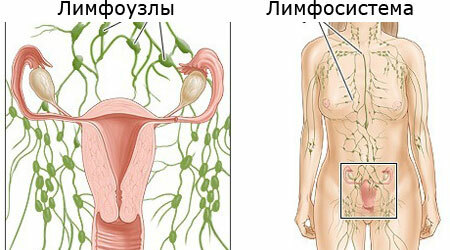High temperature without symptoms in adults - a fairly frequent and understandable phenomenon.
Comfortable condition and normal operation of all functions in the body are provided by mechanisms responsible for metabolic processes - regulation of intensity and rate of heat exchange, maintaining the temperature regime in a certain range, regardless of external temperature indices.
Information on temperatura esterna( external) is tracked by thermoreceptors located on the skin and other parts of the body. The internal parameters are controlled by the central thermoreceptive neurons in the anterior hypothalamus, which react to changes in the temperature of the blood. The set benchmark for this servo is the rate indicators.
In response to any signals violation of the installation mode, there are reactions aimed at restoring normal performance, using an autonomous system, somatic and endocrine.
There is no single definition of the temperature norm, because at examination, in the majority of healthy patients it fluctuates significantly - from 36 ° С and less, up to 37,5 ° С.
Contents
- 1 Fever is a protective reaction
- 2 Causes of high temperature without symptoms in an adult
- 3 Causes of temperature 38 without symptoms in adults
- 4 Temperature 39 without symptoms
- 5 Useful and dangerous properties of fever
- 6 High temperature without symptoms in adults: what to do?
Fever is a protective reaction

Inflammatory processes cause active circulation in the body of special protein substances - pyrogens, which act on the central part of the thermoregulation of the equilibrium of heat production and heat transfer located in the hypothalamus of the brain.
Pyrogen is divided into internal - bacterial, viral and fungal elements, and external - antigen-antibody complexes circulating in blood, hormone-like proteins( interleukins), products of disintegration and inflammation of tumors.
The effect of pyrogen on the temperature center causes malfunctions in the installation range, increasing it, which is a kind of protective reaction.
High temperature creates unacceptable conditions for the development and life activity of pathogenic microbes. The intensive development of interferon, destroying the pathogenic microorganisms, begins. From which it follows that the febrile state helps purify the blood from the "alien" antigens.
In most cases, fever is accompanied by a number of symptoms and its manifestation is understandable and understandable. But there are circumstances in which elevated febrile fever( temperature), according to patients - the only symptomatology.
Causes of high fever without symptoms in an adult
We all know perfectly well that for certain reasons, just so, nothing happens. But, the long-term symptom-free temperature of 37.2 in adults, causes legitimate questions.
An increase in temperature indicators, provoke a number of hidden inflammatory and non-inflammatory nature of the causes. The most frequent, inflammatory nature of the causes are caused by:
- The presence of infections with a slow chronic course - with dental and ENT diseases, suppurative pathologies in the peritoneum, small pelvis and respiratory system;
- Common infections of an erased and atypical course - with sepsis, brucellosis and malaria, typhoid, or tuberculosis. With the flow of latent infections or constant fatigue and loss of strength, due to infectious mononucleosis;
- Autoimmune processes - vasculitis, rheumatoid arthritis, etc.;
- Diseases of an allergic nature.
Causes of non-inflammatory may occur due to:
- Diseases of the blood - leukemia, tumor formations, paproteinemia states;
- Endocrine pathologies, in the form of thyrotoxicosis;
- Organic diseases of the CNS - post-traumatic, neoplastic, neuroinfectious pathologies.
The list is quite wide and to determine the true cause the patient has to undergo an examination to exclude many serious pathologies. If they are not identified, this condition is called functional, which is very common in medical practice.
Diagnostic status such as thermoneurosis due to instability of the nervous structures, due to the presence of autonomic dysfunction in the autonomous zone of the nervous system, not associated with the brain.
Provoke a fever - a bad relationship in the family or problems at work, an incorrect, chaotic regime of life or chronic stress.
Often, a long subfebrile condition occurs after cold infections that have been carried on the feet. Under such conditions, the body is overstrained, causing a failure of the normal temperature range and an increase in temperature in adults without symptoms of a cold.
In medicine, this is called the "temperature tail", which can last for many months, cause anxiety in patients and a constant desire to identify the cause.
Causes of temperature 38 without symptoms in adults

There is no such person who has not experienced, under any circumstances, the manifestation of febrile fever. But, sometimes there is an increase in the adult temperature to 38 ° C without symptoms and it can last for a long time. Call it can:
- physical overvoltage;
- strong stressful experiences;
- hyperthermia, due to long sun exposure;
- digestive disorders;
- allergic reactions;
- response to the introduction of vaccines;
- alcohol poisoning.
If such indicators stay more than three days and continue to increase, this may indicate the development of inflammatory processes in the tissue structures of the cardiovascular system or infarction, inflammatory processes in the kidneys and lungs, as a consequence of the violation of nervous regulation in various systems and organs.
The most unpleasant thing is when such temperature indicators persist for a long time - weeks, months.
This may be a sign of development in the body of tumor formations or neoplastic disorders in the hematopoietic system, endocrine serious pathologies, or diffuse processes in the liver and lungs. At the same time, there may not be a strong symptomatology, but to manifest itself:
- by a decay or increased excitability;
- by sharp weight loss;
- signs of alopecia( hair loss).
Temperature 39 without symptoms
In addition to the typical causes of febrile fever, the frequent cause of 39 ° C without symptoms is caused by:
- Acute manifestation of meningococcal infection manifested by temperature jumps before the appearance of the main symptomatology, which manifests itself after a certain time. To bring down a fever independently it is possible not always and for a short while.
- Reactions to tumor processes caused by damage and changes in tissue structures.
- The manifestation of clinical forms of catarrhal tonsillitis, the temperature at which it rises long before the diffuse hyperemia, swelling or mucopurulent exudate. And also the development of infectious endocarditis, as a consequence of the transferred flu or tonsillitis.
- Hypothalamic symptom complex, combining disorders in metabolic, endocrine and vegetative processes. High fever is caused by disturbances in the subcortical center system of the brain and does not show any signs and symptoms. This state can last for many years. The body is able even to get used to it.
- Symptoms do not appear even in chronic inflammatory processes in the renal-renal system of the kidneys, and high temperature values last a very long time.
Useful and dangerous properties of the
fever On the question: "Is it necessary to bring down the temperature?" - it is impossible to answer unambiguously. With its febrile manifestation, there is a sharp slowdown in the growth and multiplication of pathogens, while in the case of a hectic fever( 40 ° C), their reproduction completely ceases, and the action of antibiotics on the contrary intensifies.
This suggests that with any infectious disease, fever with high febrile indications contributes to the rapid disposal of infection.
 The immune system is activated, the production of interferon and antibodies is intensified, which fight against foreign bacteria and viruses. Decrease in motor activity with high febrileity, stimulates the body's strengths to successfully fight the disease.
The immune system is activated, the production of interferon and antibodies is intensified, which fight against foreign bacteria and viruses. Decrease in motor activity with high febrileity, stimulates the body's strengths to successfully fight the disease.
If we start to knock it down, we make it easy for a certain time, but we stop the body from destroying the infection.
But not everything is as good as we would like. High febrile fever is dangerous for the cardiovascular and endocrine system, and if they last for a long time, they experience a big "force-majeure" load.
In addition, cerebral activity suffers, and a strong manifestation of fever contributes to delusional state, the manifestation of seizures and exacerbation of chronic diseases.
It is for these reasons that a safe threshold is set in which the temperature is not brought down: for adults it is 38.5 ° C, for children - 38 ° C.
High temperature without symptoms in adults: what to do?
The first thing to do is to undergo a clinical and laboratory-instrumental examination to determine the cause.
In the case of thermoneurosis, elimination of the "temperature tail" is carried out:
- by a well-established regimen and a nutritional diet;
- sedatives soft action;
- with acupuncture and phytotherapy;
- with massage and psychotherapy;
- with yoga techniques and choreography classes.
Sometimes, after learning the main causative factor of thermoneurosis, in a patient for a few days the pathology self-healing. The main thing is to adjust the patient to recovery.
High febrile temperature is a clear symptom of serious pathology. Self-treatment will only complicate the situation. With chaotic self-selection of drugs, you can destroy one microorganism, but strengthen the action of others.
Only the doctor, having determined the cause, is able to make a competent protocol of treatment.



